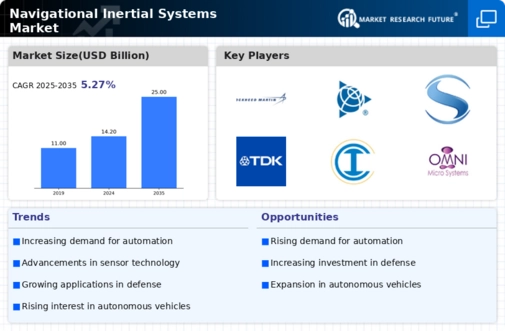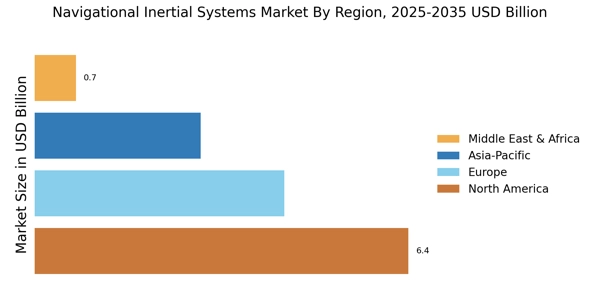Expansion of Aerospace Sector
The Navigational Inertial Systems Market is significantly influenced by the expansion of the aerospace sector. With the increasing number of commercial flights and the rise of space exploration initiatives, the demand for reliable navigation systems is on the rise. In 2025, the commercial aviation market is projected to reach a valuation of over 800 billion USD, necessitating advanced inertial navigation systems for aircraft. These systems are essential for ensuring safety and efficiency in flight operations, particularly in adverse weather conditions. As the aerospace industry continues to evolve, the reliance on navigational inertial systems is expected to intensify, driving market growth.
Increased Military Expenditure
The Navigational Inertial Systems Market is experiencing a notable surge due to increased military expenditure across various nations. Governments are investing heavily in advanced navigation systems to enhance the operational capabilities of their defense forces. For instance, the global military spending reached approximately 2 trillion USD in 2025, with a significant portion allocated to upgrading navigation technologies. This trend is driven by the need for precision in military operations, where inertial navigation systems play a crucial role in ensuring accurate positioning and guidance. As nations prioritize defense modernization, the demand for sophisticated navigational inertial systems is likely to grow, thereby propelling the market forward.
Rising Demand for Precision Agriculture
The Navigational Inertial Systems Market is also benefiting from the rising demand for precision agriculture. Farmers are increasingly adopting advanced technologies to optimize crop yields and improve operational efficiency. Inertial navigation systems are integral to precision farming, enabling accurate positioning for automated machinery and drones. The precision agriculture market is projected to reach 10 billion USD by 2025, highlighting the growing reliance on navigational technologies in agriculture. This trend indicates that as agricultural practices evolve, the demand for navigational inertial systems will likely expand, contributing to the overall market growth.
Advancements in Miniaturization Technology
The Navigational Inertial Systems Market is witnessing a transformative phase due to advancements in miniaturization technology. The development of smaller, more efficient inertial sensors has made it feasible to integrate these systems into a wider array of applications, from consumer electronics to automotive systems. As of 2025, the miniaturization trend is expected to drive the market for navigational inertial systems, with a projected growth rate of 8% annually. This evolution suggests that as devices become more compact and versatile, the demand for innovative navigational solutions will likely increase, thereby enhancing the market landscape.
Emergence of Smart Transportation Solutions
The Navigational Inertial Systems Market is poised for growth due to the emergence of smart transportation solutions. As urbanization accelerates, cities are increasingly adopting intelligent transportation systems to improve traffic management and enhance safety. The integration of inertial navigation systems into these smart solutions is crucial for real-time tracking and navigation. In 2025, the smart transportation market is anticipated to surpass 200 billion USD, indicating a robust demand for advanced navigational technologies. This trend suggests that as cities invest in smart infrastructure, the need for sophisticated navigational inertial systems will likely increase, further propelling market dynamics.

















Leave a Comment